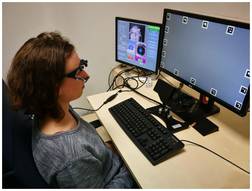Main content
Top content
Back
13. March 2020 : New publication on eye-tracking

In recent months the Neurobiopsychology lab published some very interesting papers that we haven’t featured here so far. We will do so successively in the coming weeks, starting with this new publication on eye-tracking:
Ehinger BV, Groß K, Ibs I and König P (2019). A new comprehensive eye-tracking test battery concurrently evaluating the Pupil Labs glasses and the EyeLink 1000. https://doi.org/10.7717/peerj.7086. PeerJ 7:e7086
„Eye-tracking experiments rely heavily on good data quality of eye-trackers. Unfortunately, it is often the case that only the spatial accuracy and precision values are available from the manufacturers. These two values alone are not sufficient to serve as a benchmark for an eye-tracker. To obtain a more comprehensive description of properties, we developed an extensive eye-tracking test battery. In 10 different tasks, we evaluated eye-tracking related measures such as: the decay of accuracy, fixation durations, pupil dilation, smooth pursuit movement, microsaccade classification, blink classification, or the influence of head motion. For some measures, true theoretical values exist. For others, a relative comparison to a reference eye-tracker is needed. Therefore, we collected our gaze data simultaneously from a remote EyeLink 1000 eye-tracker as the reference and compared it with the mobile Pupil Labs glasses. To conclude, our eye-tracking test battery offers 10 tasks that allow us to benchmark the many parameters of interest in stereotypical eye-tracking situations and addresses a common source of confounds in measurement errors (e.g., yaw and roll head movements). All recorded eye-tracking data (including Pupil Labs’ eye videos), the stimulus code for the test battery, and the modular analysis pipeline are freely available (https://github.com/behinger/etcomp).“

